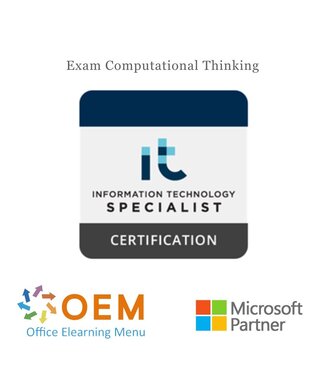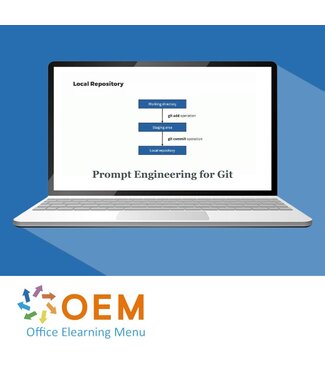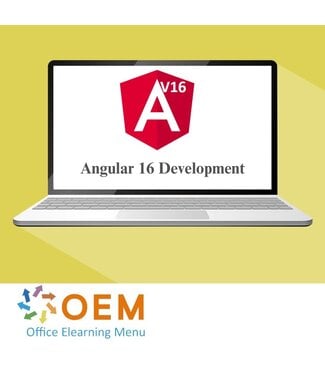Exam Computational Thinking
Candidates for this exam decompose problems, collect and analyze data, recognize patterns in data, represent data through abstractions, and automate solutions by using algorithmic thinking.
Candidates for this certification understand how to employ strategies for understanding and solving
problems in ways that leverage the power of computing principles to develop solutions. Candidates know
how to decompose problems, collect and analyze data, recognize patterns in data, represent data through abstractions, and automate solutions by using algorithmic thinking. Candidates know how to collaborate with others and also how to create computational artifacts to communicate the problem and its solution to others. Candidates have at least 150 hours of instruction and/or practical experience analyzing, collaborating on, and solving problems using computing principles like decomposition, pattern recognition, sequencing, conditional logic, and iteration. This exam is mapped to the International Society for Technology in Education (ISTE) for alignment with the ISTE Computational Thinker Standard for Students (Standards 5A, 5B, 5C, and 5D). After each objective title below, the ISTE standard or standards to which the items for this objective could potentially map is indicated in parentheses.
To be successful on the test, the candidate is also expected to have the following prerequisite knowledge
and skills:
- 8th grade reading skills
- Digital literacy skills, including the ability to research, create content, and solve problems using
technology
1. Foundational Concepts
1.1 Understand and recognize different types of data (ISTE 3B, 5B)
- Understand and recognize structured and unstructured data
- Understand and recognize different types of data such as text, numeric, date/time, image, and audio
- Understand and recognize data encoding (ascii, binary, character mapping)
1.2 Recognize and apply logical reasoning (ISTE 3A, 5B)
- Recognize and apply Boolean and logical operators
- Recognize and apply inductive reasoning
- Recognize ambiguity in a logical reasoning problem
- Recognize and apply deductive reasoning
1.3 Explain algorithmic thinking (ISTE 5A, 5D)
- Explain the purpose of algorithmic thinking
- Understand the purpose of abstraction and model building
- Understand the purpose and capabilities of automation
2. Identify and Collect Data
2.1 Assess data needs and available data (ISTE 3B, 5B, 5C)
- Identify the data needed to solve a problem
- Assess relevance of existing data sets
- Determine the gap between existing data and data needs
2.2 Understand data quality (ISTE 3B, 5B)
- Understand validity
- Understand reliability
- Explain data cleaning in data sets
2.3 Collect the data needed to solve a problem (ISTE 1D, 2B, 3B, 3C, 5B)
- Collect relevant data using existing data sources
- Including selection of appropriate tools to gather, analyze, and process data
- Including retrieval of information from a data source, such as a list, a table, an infographic, etc.
- Choose a method for creating original data sets such as an observation or a survey
- Including input-validation methods
- Explain the legal and ethical dimensions of data collection
3. Apply Abstraction
3.1 Identify patterns in and apply abstraction to data (ISTE 5A, 5B, 5C)
- Identify patterns in data
- Organize data using models such as tables, charts, and graphs
- Sort and filter data by relevant criteria
- Identify similarities, differences, and subsets in a data set
- Make predictions by examining patterns
3.2 Recognize, create and interpret abstract models (ISTE 5C, 5D)
- Recognize an abstract representation, such as a model, variable, function, or procedure
- Create an abstract model to understand complex systems or facilitate problem solving
- Interpret a process flow diagram
4. Specify a Solution
4.1 Define and decompose a problem (ISTE 4B, 5A, 5C)
- Identify an appropriate problem statement based on information provided
- Define the scope and limitations of a problem
- Identify decision makers, collaborators, and target audience
- Break down a problem into component parts by using decomposition
4.2 Identify requirements (ISTE 4A, 4B, 6A)
- Select a design process, such as iterative or incremental
- Identify prerequisites for a solution
- Identify the possible outcomes of a solution
- Choose appropriate tools to develop a solution, such as flow charts, spreadsheets, pseudocode, surveys
5. Automate a Solution
5.1 Use a sequence of steps in algorithms (ISTE 5B, 5D)
- Create a sequence of steps
- Evaluate the outcome of a sequence of steps
- Recognize when to combine steps into reusable procedures and functions
5.2 Automate repetitive tasks by using iteration (ISTE 5D)
- Recognize when to use iteration
- Including when to use nested loops
- Determine the outcome of an algorithm that uses iteration
- Create an algorithm that uses iteration
5.3 Use selection statements in algorithms (ISTE 5D)
- Recognize when to use selection statements
- Including when to use nesting in selection statements
- Determine the outcome of an algorithm that uses selection statements
- Create an algorithm that uses selection statements
5.4 Use variables in algorithms (ISTE 5D)
- Recognize when to use variables
- Determine the outcome of an algorithm that uses variables
- Create an algorithm that uses variables
6. Present and Improve a Solution
6.1 Produce a computational artifact to present a solution to a target audience (ISTE 6A, 6C, 6D)
- Choose an effective medium for communicating a solution to a target audience
- Including video, flow diagram, pdf, html prototype, chart, infographic, diagram, graph
- Create an original computational artifact to communicate a solution to a target audience
6.2 Collaborate on computational artifacts (ISTE 1C, 7B)
- Interpret a design for a computational artifact
- Critique and provide feedback on a design for a computational artifact
- Incorporate collaborative feedback into a computational artifact
6.3 Perform iterative design on an automated solution (ISTE 1D, 4C, 5C, 5D)
- Create a prototype to evaluate the effectiveness of an automated solution
- Compare the efficiency of multiple possible solutions
- Troubleshoot an automated solution
- Use iterative testing to improve an automated solution





